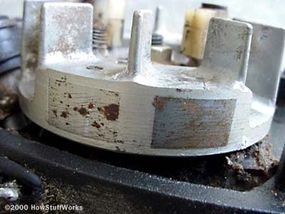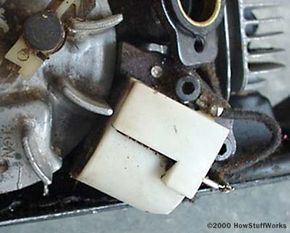Most small lawn mowers, chain saws, trimmers and other small gasoline engines do not need a battery. Instead, they actually generate the power for the spark plug using a magneto. Magnetos are also used on many small airplanes (for example, the Cessna 152 seen in How Airplanes Work) because they are extremely reliable.
The idea behind any ignition system is to generate an extremely high voltage -- on the order of 20,000 volts -- at exactly the right time. The voltage causes a spark to jump across the spark plug's gap, and the spark ignites the fuel in the engine. See How Car Engines Work or How Two-Stroke Engines Work for details.
Advertisement
The magneto is the white block in the following photo (this is the magneto for a chain saw):
The idea behind a magneto is simple. It is basically an electrical generator that has been tuned to create a periodic high-voltage pulse rather than continuous current. An electrical generator (or a magneto) is the reverse of an electromagnet (see How Electromagnets Work for details). In an electromagnet there is a coil of wire around an iron bar (the armature). When you apply current to the electromagnet's coil (e.g. with a battery), the coil creates a magnetic field in the armature. In a generator, you reverse the process. You move a magnet past the armature to create electric current in the coil.
A magneto consists of five parts:
- An armature. In the above magneto, the armature is shaped like a capital "U". The two ends of the U point toward the flywheel.
- A primary coil of perhaps 200 turns of thick wire wrapped around one leg of the U
- A secondary coil of perhaps 20,000 turns of very thin wire wrapped around the primary coil
- A simple electronic control unit that commonly goes by the name "electronic ignition" (or a set of breaker points and a capacitor)
- A pair of strong permanent magnets embedded in the engine's flywheel.
You can see the two magnets in the following photo:

When the magnets fly past the U-shaped armature, they induce a magnetic field in the armature. This field induces some small amount of current in the primary and secondary coil. What we need, however, is extremely high voltage. Therefore, as the magnetic field in the armature reaches its maximum, a switch in the electronic control unit opens. This switch breaks the flow of current through the primary coil and causes a voltage spike (of perhaps 200 volts). The secondary coil, having 100 times more turns than the primary coil, amplifies this voltage to approximately 20,000 volts, and this voltage feeds to the spark plug.
Many riding lawn mowers do have a battery if they have accessories like headlights and electric start. Even so, the engine may use a magneto because the magneto is simple and reliable.
You can learn more about magnetos from these links:
- Magnetos - great intro info
- Old engine magnetos and ignition systems
- BMW Ignition systems
- Magneto and spark plugs
- Ignitions
- Lawn Mower Questions and Answers
- Spark coil
Advertisement
